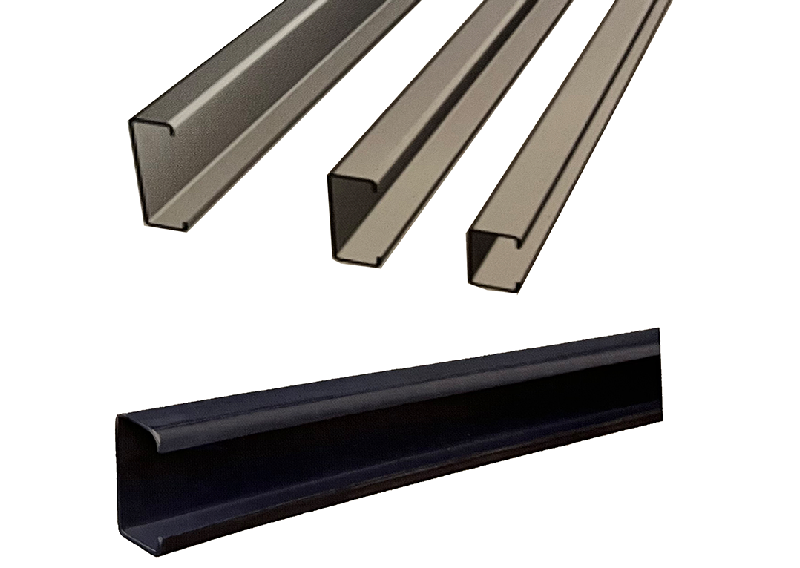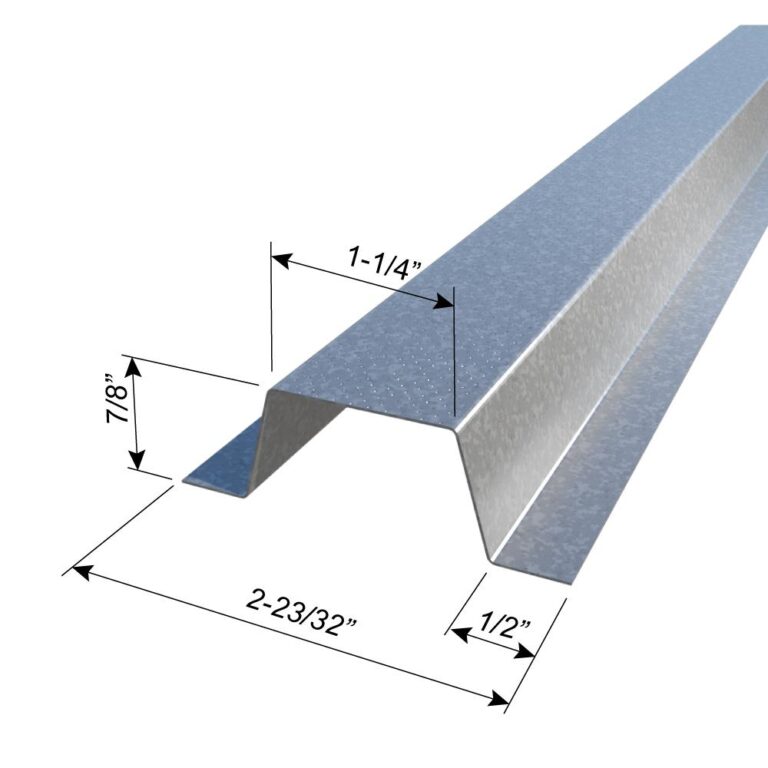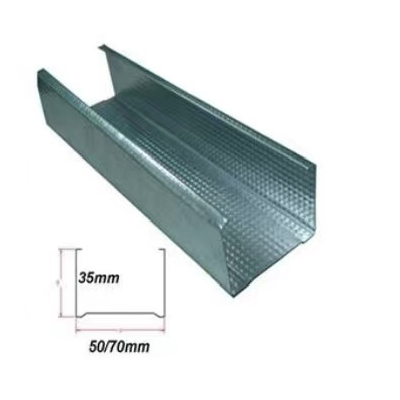What is a Metal Channel? Comprehensive Guide to Understanding Metal Channels
You will learn
What is a metal channel?
A metal channel refers to a structural or architectural element made from metal, typically in the shape of a “C” or “U.” It is used in a variety of applications, including construction, manufacturing, and engineering, for support, framing, and other structural purposes. Metal channels are typically made from steel, aluminum, or other metals, and their cross-sectional shape provides strength and rigidity.
Steel channels are available in different types, including hot-rolled steel channels and cold-formed steel channels. Hot-rolled steel channels are created through a heating and rolling process, while cold-formed steel channels are formed through a series of bending and folding operations.
The flat surface of steel channels is also useful in creating custom shapes and designs. Fabricators can easily modify the steel channels by cutting, drilling, or bending them to fit specific applications. They can also attach accessories or other materials to the flat surface of the steel channel to enhance its functionality.
Types of metal channel shapes
Metal channels are essential components in construction, manufacturing, and various industrial applications, providing structural support and reinforcement. These channels are created through a high-speed roll forming process, which shapes metal into linear profiles tailored to the specific needs of each project. The most common metal channel shapes include C, U, J, and Hat channels, each designed for particular uses based on their unique profiles.
C Channel
C channels are among the most widely used metal channels, especially in construction. Their profile resembles the letter “C,” with a base known as the web and two flanges on either side. The flanges can sometimes be crimped or folded back for added strength. C channels are highly versatile and are used for building walls, roofing, ceilings, and other structural supports. Due to their adaptability, C channels come in numerous sizes and variations to meet the specific requirements of each application.

Hat Channel
Hat channels get their name from their distinctive shape, which resembles a wide-brimmed hat. The base is flanked by vertical sides, with the top edges bent outward. This profile makes hat channels particularly well-suited for use in roof framing, where they are often referred to as hat purlins. Hat channels offer excellent strength and support and are commonly available in standard lengths, though custom lengths can also be ordered for specific projects.

U Channel
U channels are characterized by their simple U-shaped profile, created by forming two right angles in a flat strip of metal. These channels are available in various dimensions, with the width of the base and the height of the sides adjustable to meet specific needs. U channels are frequently used in framing, edge protection, and architectural applications, making them a popular choice across different industries.

Here are some key uses of metal channels
Construction: Metal channels are often used as part of building frameworks, where they provide support for walls, ceilings, or floors.
Electrical and Cable Management: Metal channels are used to protect and organize cables, electrical wiring, and other utilities.
Support Structures: Channels are commonly used in scaffolding, shelving systems, and in the construction of metal furniture or equipment.
Bridges and Roads: They are also used in the construction of bridges, roads, and other large-scale infrastructure to provide reinforcement and load distribution.
The channels can come in different sizes and are typically classified based on their dimensions, material, and strength properties.
How Metal Channels are Roll Formed
Metal channels are produced through a manufacturing process called roll forming, where a metal sheet or strip is continuously bent into a desired profile as it passes through a series of rollers, known as stands. This high-speed process is ideal for creating consistent shapes with high precision, making it a cost-effective solution for large-scale production of metal channels. The roll forming technique allows for the creation of complex profiles with minimal need for further processing.
CAD Design
The roll forming process begins with a computer-aided design (CAD) that defines the geometry, dimensions, and metal type for the desired channel profile. CAD software is crucial in roll forming, as it generates detailed models that show how the metal will be shaped incrementally through each stand. The CAD design can be converted into G codes for input into a computer numerical controlled (CNC) roll forming machine, ensuring precise and consistent shaping.
Sheet Metal Coil Feeding
The process starts with a metal coil placed on an uncoiler or decoiler. This device feeds the metal sheet into the roll forming machine in a continuous manner. The uncoiler ensures smooth and controlled entry of the metal strip, preparing it for the subsequent shaping stages.
Pre-Processing Treatment
Before entering the roll forming machine, the metal sheet may undergo pre-processing treatments such as hole punching, slot cutting, or other custom patterns. This is done using an in-line punching machine with sharp tools that apply force to the metal in a controlled manner. Pre-processing ensures that any necessary holes or notches are precisely made before the channel is formed.
Roll Forming Dies Setup
The roll forming machine is equipped with a series of precision-engineered dies placed in multiple stations. Each set of rollers, or stands, incrementally bends the metal into its final shape. The design of the dies is tailored to the specific requirements of the metal channel being produced, ensuring the desired profile is achieved.
Roll Forming Process
Once the dies are in place and the metal strip is fed into the machine, the actual roll forming process begins. The metal passes through a series of rollers, each one gradually bending the metal to match the channel’s profile. Depending on the complexity of the design, the metal may pass through a few or dozens of stations before the final shape is achieved. This step is crucial for ensuring the precision and quality of the finished metal channel.
Final Cutting
After the channel is fully formed, it is cut to the required length. The cut may happen either at the end of the roll forming process or during a pre-programmed point within the machine. Once cut, the metal channels are collected on a receiving platform or set of rollers. This marks the completion of the roll forming process.
Composition of U-shaped keel machine?
- Material Dispenser: Feeds the metal coil into the machine.
- Guiding Frame: Ensures proper alignment of the metal strip.
- Forming Host: The primary machine where the roll forming occurs.
- Calibration Device: Ensures precision in the final shape.
- Fixed Cutting Section: Cuts the finished channel to the desired length.
- Receiving Platform: Collects the final product.
- Electrical Control Part: Manages the machine’s operation, typically integrated with CAD software for precise control.
The function of U-shaped keel machine?
- Production of standardized keel: The U-shaped keel machine can quickly and accurately process metal sheets (usually galvanized steel plates or other types of steel) into standard sized U-shaped keels, which have a uniform cross-sectional shape and size, making them easy to use in construction.
- Improve production efficiency: Through automated or semi automated production processes, U-shaped keel machines greatly improve production efficiency and reduce errors and costs caused by manual operations.
- Ensure product quality: Machine production can ensure the consistency of each product, thereby ensuring the quality stability of construction projects.
- Flexible adjustment of production specifications: According to different engineering requirements, the U-shaped keel machine can produce keels of different widths, heights, and thicknesses by adjusting molds or parameters, meeting diverse building needs.
- Material saving: Through precise cutting and forming processes, the U-shaped keel machine can ensure the quality of the finished product while maximizing the use of raw materials and reducing waste.
- Suitable for mass production: For large-scale construction projects, the U-shaped keel machine is very suitable for large-scale keel production tasks and can meet the needs of large-scale construction projects.
- Environmental protection and energy conservation: Compared with traditional handmade methods, using a U-shaped keel machine for production can reduce energy consumption and environmental pollution, which meets the requirements of modern construction industry for environmental protection.